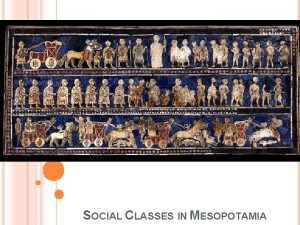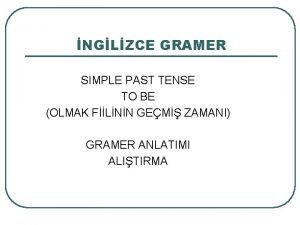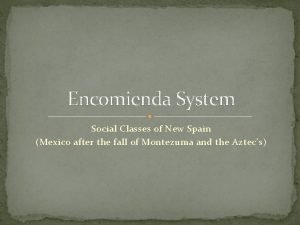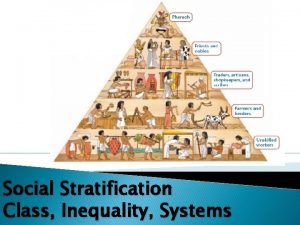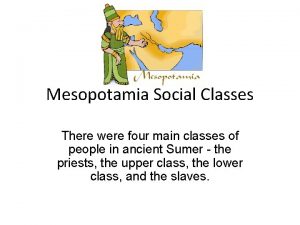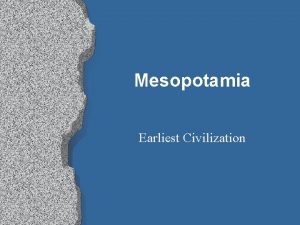SOCIAL CLASSES IN MESOPOTAMIA SOCIAL CLASSES There were







- Slides: 7

SOCIAL CLASSES IN MESOPOTAMIA

SOCIAL CLASSES There were three main classes of people in ancient Mesopotamia � the upper class � the middle class � the lower class/slaves

THE UPPER CLASS People in the upper class were powerful and wealthly. The upper class included � the kings � Nobles � Priests � government officials � warriors

THE UPPER CLASS-PRIESTS The priests were powerful. The priests shaved their heads. They were in charge of making sure everyone behaved in a way that would make the gods happy. Priests were responsible for developing the economy. Priests distributed land, employed workers and managed trade. They were the doctors of the time. If you were sick, you called for a priest.

THE UPPER CLASS- WEALTHY MEN AND WOMEN Men and women wore jewelry, especially rings. Men wore skirts and had long hair, curly moustaches, and long beards. Women wore dresses, off one shoulder. They had long hair, which they braided or wore up in fancy arrangements.

THE MIDDLE CLASS The middle class was made up of: � � Farmers Fisherman Artisans Merchants In ancient Sumer, people were paid for their work. If they ran a shop or worked in the fields, they were paid for their goods or labor. Everybody paid, even the king. Stealing was a serious crime and punishment was severe. Although the lower class did not have the luxury lifestyle of the rich, they were comfortable. They worked very hard, but they had homes. They wore jewelry, although perhaps it was not made of gold. There was no law that said they could not move up the social scale, or more likely, have their children move up the social scale by becoming a scribe, or a priest or priestess.

THE LOWER CLASS- SLAVES Slaves performed all manual and domestic work. Slaves worked for the king, the temple and the wealthy. Slaves were taken at the end of wars between the city-states. Among the slaves were captured people, debtors, poor children, orphans and criminals. Slaves were bought and sold. Records have been found recording the amount paid for a slave. Typically, a slave bought at auction cost less than a donkey but more than a cow. Slaves who tried to escape or disobeyed their masters received harsh punishments. Despite being the property of their masters, slaves still had many rights. They could hold property, participate in business, marry a free man or women, and eventually even purchase their own freedom.
